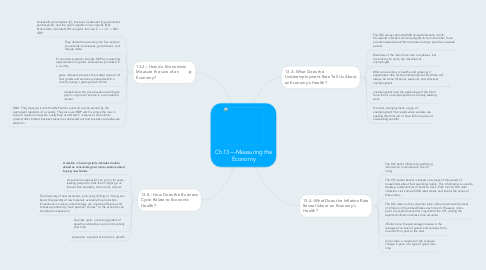Ch.13---Measuring the Economy
by MATHEW VOULGARAKIS

1. 13.3--What Does the Underemployment Rate Tell Us About an Economy's Health?
1.1. The BLS surveys about 60,000 households each month. Household members who are eligible to be in the labor force are interviewed about their activities during a specific one-week period.
1.2. Members of the labor force who are jobless, but are looking for work, are classified as unemployed.
1.3. When an economy is healthy and growing, it experiences little cyclical unemployment. But there will always be some frictional, seasonal, and structural unemployment.
1.3.1. When an economy is healthy and growing, it experiences little cyclical unemployment. But there will always be some frictional, seasonal, and structural unemployment.
1.4. unemployment rate: the percentage of the labor force that is not employed but is actively seeking work
1.5. frictional unemployment: a type of unemployment that results when workers are seeking their first job or have left one job and are seeking another
2. 13.2-- How do Economists Measure the size of an Economy?
2.1. household consumption (C), business investment (I), government purchases (G), and the net of exports minus imports (NX). Economists calculate GDP using this formula: C + I + G + NX = GDP
2.2. They divide the economy into four sectors: households, businesses, government, and foreign trade.
2.3. Economists typically calculate GDP by measuring expenditures on goods and services produced in a country.
2.4. gross domestic product: the market value of all final goods and services produced within a country during a given period of time
2.5. market value: the price buyers are willing to pay for a good or service in a competitive market
2.6. LINK: They measure it with the GNP witch counts all income earned by the permanent residents of a country. They also use NNP witch is simply the loss in value of capital and assets. Lastly they use NI witch is equal to net national product after indirect business taxes are subtracted out and business subsidies are added in.
3. 13.4--What Does the Inflation Rate Reveal About an Economy's Health?
3.1. The BLS tracks inflation by gathering information on Americans’ cost of living.
3.2. The CPI market basket is based on surveys of thousands of households about their spending habits. This information is used to develop a detailed list of items to track. Each month, BLS data collectors visit some 25,000 retail stores and record the prices of these items.
3.3. The BLS relies on the consumer price index to estimate the level of inflation in the United States each month. However, critics point to several biases that may distort the CPI, making the reported inflation rate less than accurate.
3.4. inflation rate: the percentage increase in the average price level of goods and services from one month or year to the next
3.5. price index: a measure of the average change in price of a type of good over time
4. 13.5-- How Does the Business Cycle Relate to Economic Health?
4.1. A decline in housing starts indicates trouble ahead as consumers grow more cautious about buying new homes.
4.2. An economic expansion can go on for years, leading people to think that it might go on forever. But inevitably, boom turns to bust.
4.3. The discovery of new resources, such as by drilling or mining, can boost the quantity of raw materials available for production. Innovations in science or technology can improve efficiency and increase productivity. Such positive “shocks” to the economy can stimulate an expansion.
4.4. business cycle: a recurring pattern of growth and decline in economic activity over time
4.5. expansion: a period of economic growth



